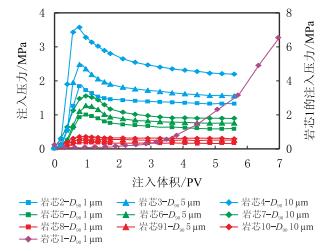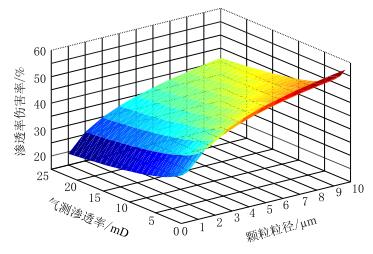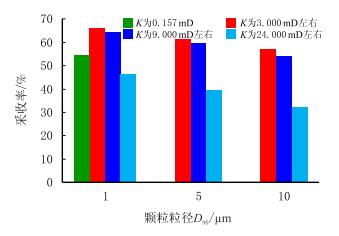2. "油气藏地质及开发工程"国家重点实验室·西南石油大学, 四川 成都 610500;
3. 中国寰球工程公司新疆分公司, 新疆 克拉玛依 833600
2. State Key Laboratory of Oil and Gas Reservoir Geology and Exploitation, Southwest Petroleum University, Chengdu, Sichuan 610500, China;
3. China Huanqiu Contracting & Engineering Company, Karamay, Xinjiang 833600, China
注入水水质直接影响油田水驱开发效果,悬浮固体颗粒粒径中值是注入水水质的重要指标之一。对于中低渗透砂岩油藏,颗粒粒径过大易伤害储层,严重影响油藏的注水开发效果[1-6]。将注入水中固相颗粒的粒径处理的越小,对水质处理的要求就越高,必然会增加水质处理的成本,因此需要研究水质指标的合理性。为此,针对温度80 ℃,渗透率0.1~25.0 mD,孔隙度14%~20%的油藏条件下,研究注入水中不同粒径固相悬浮颗粒的注入性以及对储层的伤害程度,并分析其在低渗透岩芯中的渗流特征和对采收率的影响,为该类油藏注水开发制定合理的水质指标提供参考。
1 固相颗粒粒径对注入性的影响利用Mastersizer2000激光粒度分析仪,分析3种处理后的注入水中悬浮固体颗粒(超细碳酸钙)的粒径组成[7-9]。注入水中悬浮固体颗粒的累计粒度分布达到90%时所对应的粒径(D90)[10-11]分别为1.24,5.05,9.91 µm;分别记为D90 1 µm、D90 5 µm和D90 10 µm。其中悬浮固相颗粒浓度为3 mg/L。
实验用天然岩芯,按照SY/T 5336-1996《岩芯常规分析方法》进行清洗并测定岩芯基本参数。分别选取渗透率为0.200,3.000,9.000,24.000 mD的岩芯,具体参数见表 1。
| 表1 岩芯物性参数 Table 1 Core physical parameters |
首先将10块岩芯抽空饱和地层水,在80 ℃恒温箱中,饱和模拟油(80 ℃,4.8 mPa·s)建立束缚水饱和度,测定油相有效渗透率Ko1,然后以0.5 mL/min的流速注入含有不同粒径固相颗粒的水,驱替模拟油[12-14],考察水驱过程中注入压力随注水PV数的变化,如图 1所示。
 |
| 图1 注入压力随注水体积的变化曲线 Fig. 1 Relation between injection pressure and injected water volumes |
由图 1可知,在岩芯1中,D90 1 µm的注入水存在注入性问题。分析认为,渗透率为0.157 mD的岩芯孔隙半径较小,固相颗粒无法完全进入孔隙中,在注入端聚集,注入压力逐渐升高;当注入体积达到一定值时,注入水中的颗粒在注入端的浓度越来越高,形成滤饼,导致注入压力急剧增加,最终堵塞岩芯。
在渗透率大于1.000 mD的岩芯中,相同颗粒粒径的注入水,随着岩芯渗透率的增加,注入压力呈下降趋势。在渗透率相近的岩芯中,随着注入水中固相颗粒粒径的增大,最高注入压力以及水驱平衡压力均增加。分析认为,由于注入水中颗粒的浓度较低,悬浮在水中的颗粒随着注入水进入到岩芯中,没有在注入端形成架桥堵塞现象[15-16],均表现出良好的注入性。但当较大粒径颗粒进入岩芯后,封堵了岩芯中的大孔道,迫使注入水转向流入较小孔喉直径的小孔隙,造成注入压力升高。
2 注水固相颗粒粒径对储层伤害的影响分别研究了不同粒径颗粒对油相渗透率的伤害程度[17-20]。用模拟油正向测得岩芯初始油相有效渗透率Ko1以及岩芯的原始含油饱和度Soi,然后用含有不同粒径的固相颗粒(浓度为3 mg/L)的水进行水驱,直至含水率大于98%,记录水驱实验结束时的注入压力DP1,计算含水率和采收率;然后用地层水以2DP1的压差反向驱替岩芯,压力稳定后停止实验;再次用模拟油正向驱替岩芯计算岩芯的油相有效渗透率Ko2。
岩芯渗透率伤害率(D)的计算公式:$D=({K_{{\rm{o}}1}}-{K_{{\rm{o}}2}})/{K_{{\rm{o}}1}} \times 100\% $。不同岩芯的油相渗透率伤害实验结果如表 2所示。
| 表2 不同渗透率岩芯固相颗粒伤害实验结果 Table 2 Core damage of different permeability caused by the solids invading |
对岩芯的渗透率,固相颗粒D90粒径,渗透率伤害率三者进行数值模拟,发现三者呈现一定的关系,获得不同固相颗粒D90粒径的伤害图版如图 2所示。
 |
| 图2 岩芯渗透率伤害图版 Fig. 2 Core permeability damage chart |
同时,研究了含有不同粒径固相颗粒注入水的驱替效果,固相颗粒粒径对水驱采收率的影响如图 3所示。
 |
| 图3 颗粒D90粒径对采收率的影响 Fig. 3 The impact of particle diameter D90 on recovery |
从表 2和图 2中可以看出,随着岩芯渗透率的增加,相同粒径固相颗粒对油相渗透率的伤害程度降低。分析认为,当进入到岩芯中的固相颗粒粒径中值超过孔隙中值的1/3时,容易在孔隙内形成桥堵,造成孔隙的堵塞;颗粒粒径越大,越容易堵塞孔隙。
当岩芯渗透率一定时,渗透率伤害率随着颗粒D90粒径增大,先快速增加又逐渐变缓。说明颗粒粒径较小时,注入水中的颗粒大部分能够进入岩芯,而当颗粒粒径增加时,部分大粒径颗粒滞留在注入端面,对岩芯的油相渗透率伤害程度减缓。由此可见,由于颗粒粒径与岩芯孔喉的相互作用,存在一定的粒径范围,使得颗粒能够随注入水进入岩芯,超过该范围的大粒径颗粒在岩芯端面形成堵塞。
以渗透率伤害率30%为界限[21],由图 2可知,当岩芯渗透率小于10.000 mD时,注入水中的颗粒D90粒径应小于1.00 µm;当岩芯渗透率大于10.000 mD时,注入水中的颗粒D90粒径可以适当放宽到5.00 µm。此时对采收率的影响程度不大。
从图 3中可以看出,岩芯渗透率为0.157 mD时,由于D90 1.00 µm的注入水存在注入性问题,影响了注水开发,采收率较低。在不影响注入性的岩芯中,随着渗透率的增加,水驱采收率呈现下降趋势。分析认为,在低渗透岩芯中总是伴随着天然裂缝,渗透率越高天然裂缝越发育,随着渗透率的增加,岩芯中尺寸较大的孔隙结构所占的比例增加;在注水过程中越容易造成注入水的窜流,影响了水驱采收率。同时,随着固相颗粒粒径的增大,岩芯中更多小孔隙的油流通道被堵塞,降低了水驱波及能力,导致水驱采收率急剧下降。
3 结论(1) 在渗透率大于1.000 mD的岩芯中,含有较低浓度固相颗粒的3种注入水能够满足注入性的要求;岩芯渗透率小于1.000 mD时,注入水中的固相颗粒D90粒径小于1.00 µm,才能满足油藏注入要求。
(2) 固相颗粒浓度一定时,岩芯伤害程度主要取决于颗粒粒径的大小和岩芯渗透率。随着颗粒粒径的增大,岩芯渗透率伤害程度逐渐加深;随着岩芯渗透率的增加,其对岩芯造成的伤害程度逐渐减小。
(3) 随着固相颗粒粒径的增加,中低渗透岩芯水驱采收率呈现下降趋势;结合不同固相颗粒D90粒径的渗透率伤害率图版,岩芯渗透率大于10.000 mD时,注入水中的颗粒D90粒径可以适当放宽到5.00 µm。
| [1] |
黄翔, 吴晓东. 义65井区高温低渗油藏储层伤害机理分析[J].
西南石油大学学报:自然科学版, 2010, 32 (4) : 115–118.
Huang Xiang, Wu Xiaodong. Formation damage mechanism analysis of high temperature and low permeability reservoir in Well Yi-65[J]. Journal of Southwest Petroleum University:Science & Technology Edition, 2010, 32 (4) : 115–118. |
| [2] | Barkman J H, Davidson D H. Measuring water quality and predicting well impairment[J]. Journal of Petroleum Technology, 1972, 24 (7) : 865–873. DOI:10.2118/3543-PA |
| [3] |
吴运强, 杜文军, 赵增义, 等. 滴水泉油田滴2井区储集层敏感性及注水适应性评价[J].
新疆石油地质, 2010, 31 (1) : 61–62.
Wu Yunqiang, Du Wenjun, Zhao Zengyi, et al. Evaluation on reservoir sensitive and waterflood suitability in Di-2 Well area of Dishuiquan Field in Junggar Basin[J]. Xinjiang Petroleum Geology, 2010, 31 (1) : 61–62. |
| [4] |
顾燕凌, 陆红军, 李建山, 等. 超低渗透油藏活性酸酸化增注技术研究[J].
西安石油大学学报:自然科学版, 2012, 27 (4) : 50–53.
Gu Yanling, Lu Hongjun, Li Jianshan, et al. Active acidization technology of superlow-permeability reservoirs for increasing water injection[J]. Journal of Xi'an Shiyou University:Natural Science Edition, 2012, 27 (4) : 50–53. |
| [5] |
袁林, 谢葵, 时维才. 注入水悬浮固体含量对低渗油藏的敏感性研究[J].
钻采工艺, 2005, 28 (5) : 108–109.
Yuan Lin, Xie Kui, Shi Weicai. Study on the sensitivity of the suspension solid content in injected water to low permeability reservoir[J]. Drilling & Production Technology, 2005, 28 (5) : 108–109. |
| [6] |
王富华, 王瑞和, 于雷, 等. 固相颗粒损害储层机理研究[J].
断块油气田, 2010, 17 (1) : 105–108.
Wang Fuhua, Wang Ruihe, Yu Lei, et al. Study on formation damage mechanism of solid particles[J]. Fault-block Oil & Gas Field, 2010, 17 (1) : 105–108. |
| [7] |
王尤富, 付利琴, 赖必智, 等. 注入水中的固相颗粒与储层损害关系的试验研究[J].
石油天然气学报, 2009, 31 (5) : 143–144,151.
Wang Youfu, Fu Liqin, Lai Bizhi, et al. Relationship between solid particles in water injection and formation damage[J]. Journal of Oil and Gas Technology, 2009, 31 (5) : 143–144,151. |
| [8] |
王丰文, 李建荣, 焦红岩, 等. 注入水中固相颗粒对地层的伤害分析[J].
断块油气田, 2003, 10 (4) : 30–32.
Wang Fengwen, Li Jianrong, Jiao Hongyan, et al. Analysis on formation damage by the solid particle within the injected water[J]. Fault-block Oil & Gas Field, 2003, 10 (4) : 30–32. |
| [9] |
秦积舜, 彭苏萍. 注入水中固相颗粒损害地层机理分析[J].
石油勘探与开发, 2001, 28 (1) : 87–88.
Qin Jishun, Peng Suping. Mechanism analysis on the formation damage by retention of particles suspended in injection water[J]. Petroleum Exploration and Development, 2001, 28 (1) : 87–88. |
| [10] |
李海涛, 王永清, 蒋建勋. 悬浮颗粒对砂岩储层吸水能力影响评价[J].
西南石油学院学报, 2006, 28 (5) : 47–49.
Li Haitao, Wang Yongqing, Jiang Jianxun. Evaluation of formation damage induced by suspended particles during water injecting[J]. Journal of Southwest Petroleum Institute, 2006, 28 (5) : 47–49. |
| [11] |
赵峰, 唐洪明, 孟英峰, 等. 花岗岩储层损害机理及保护技术研究[J].
西南石油大学学报:自然科学版, 2008, 30 (3) : 76–80.
Zhao Feng, Tang Hongming, Meng Yingfeng, et al. The damage mechanisms and protection technologies of granite reservoirs[J]. Journal of Southwest Petroleum University:Science & Technology Edition, 2008, 30 (3) : 76–80. |
| [12] |
顾军, 向阳, 何湘清, 等. 裂缝-孔隙型储层保护钻完井液体系研究[J].
成都理工大学:自然科学版, 2003, 30 (2) : 184–186.
Gu Jun, Xiang Yang, He Xiangqing, et al. Research of the drilling and completion fluid system for fracture-pore type reservoir prothction[J]. Journal of Chengdu University of Technology:Science & Technology Edition, 2003, 30 (2) : 184–186. |
| [13] |
靳文奇, 王小军, 何奉朋, 等. 安塞油田长6油层组长期注水后储层变化特征[J].
地球科学与环境学报, 2010, 32 (3) : 239–244.
Jin Wenqi, Wang Xiaojun, He Fengpeng, et al. Characteristics of Chang-6 oil-bearing formation changes after long term waterflood development in Ansai Oilfield[J]. Journal of Earth Sciences and Environment, 2010, 32 (3) : 239–244. |
| [14] |
陈在君, 金祥哲, 杨斌. ASS-1屏蔽暂堵钻井完井液体系的实验研究[J].
西南石油大学学报:自然科学版, 2008, 30 (3) : 110–112.
Chen Zaijun, Jin Xiangzhe, Yang Bin. The experiment study of Ass-1 drilling and completion fluid system of bridge plug in laboratory[J]. Journal of Southwest Petroleum University:Science & Technology Edition, 2008, 30 (3) : 110–112. |
| [15] |
高波, 王勇, 李冰, 等. 渤西油田污水回注储层损害评价研究及化学保护措施[J].
海洋石油, 2010, 30 (1) : 76–80.
Gao Bo, Wang Yong, Li Bing, et al. Research on formation damage by produced-water reinjection in Boxi Oilfield and chemical protection measures[J]. Offshore Oil, 2010, 30 (1) : 76–80. |
| [16] | 原晓珠.冀东油田注水过程中储层保护技术研究[D].荆州:长江大学, 2012 |
| [17] |
韩炜, 张公社, 黄茗, 等. 注水井固相颗粒伤害数值模拟研究及应用[J].
西安石油大学学报:自然科学版, 2005, 20 (5) : 36–40.
Han Wei, Zhang Gongshe, Huang Ming, et al. Study on the numerical simulation of the reservoir damage of the solid particle in injection water and its application[J]. Journal of Xi'an Shiyou University:Natural Science Edition, 2005, 20 (5) : 36–40. |
| [18] | Jamshid M. Modeling of permeability impairment by invasion of solid suspension during waterflooding in heterogeneous porous media[C]. SPE 111275, 2008 |
| [19] | Moghadasi J, Sharif A, Kalantari-Dahaghi A M, et al. A new model to describe formation damage during particle movement and deposition in porous media[C]. SPE 99391, 2006. |
| [20] |
李海涛, 王永清, 谭灿. 砂岩储层清水和污水混注对储层损害的实验评价[J].
石油学报, 2007, 28 (2) : 137–139,143.
Li Haitao, Wang Yongqing, Tan Can. Experimental evaluation on formation damage caused by re-injection of mixture of fresh water and produced water in sandstone reservoir[J]. Acta Petrolei Sinica, 2007, 28 (2) : 137–139,143. |
| [21] |
贾忠伟, 杨清彦, 张江. 大庆油田低渗透油层注水伤害实验研究[J].
大庆石油地质与开发, 2007, 26 (1) : 72–75.
Jia Zhongwei, Yang Qingyan, Zhang Jiang. Research on damage test of water injection in low permeability reservoir of Daqing Oilfield[J]. Petroleum Geology & Oilfield Development in Daqing, 2007, 26 (1) : 72–75. |
 2014, Vol. 36
2014, Vol. 36

